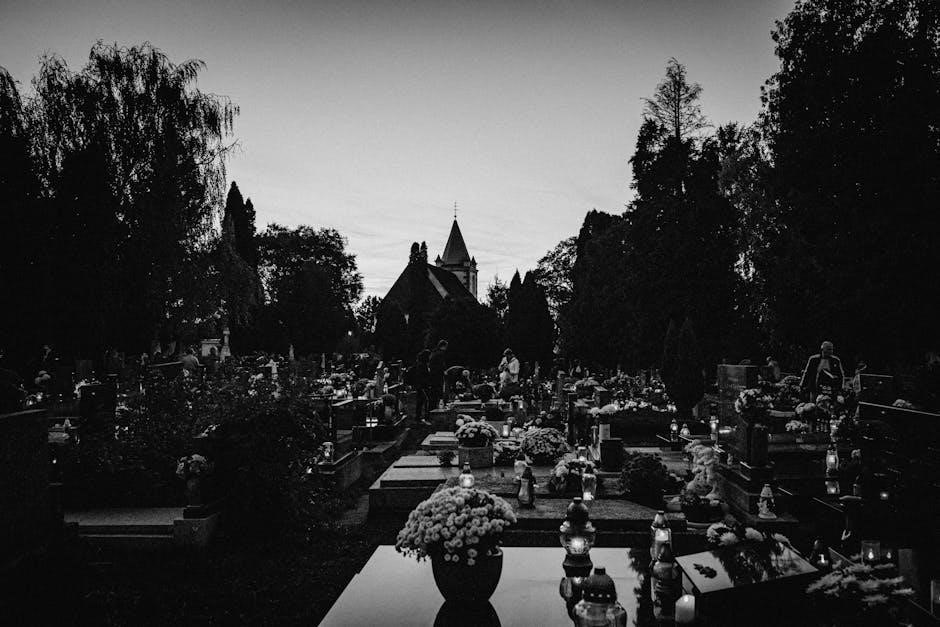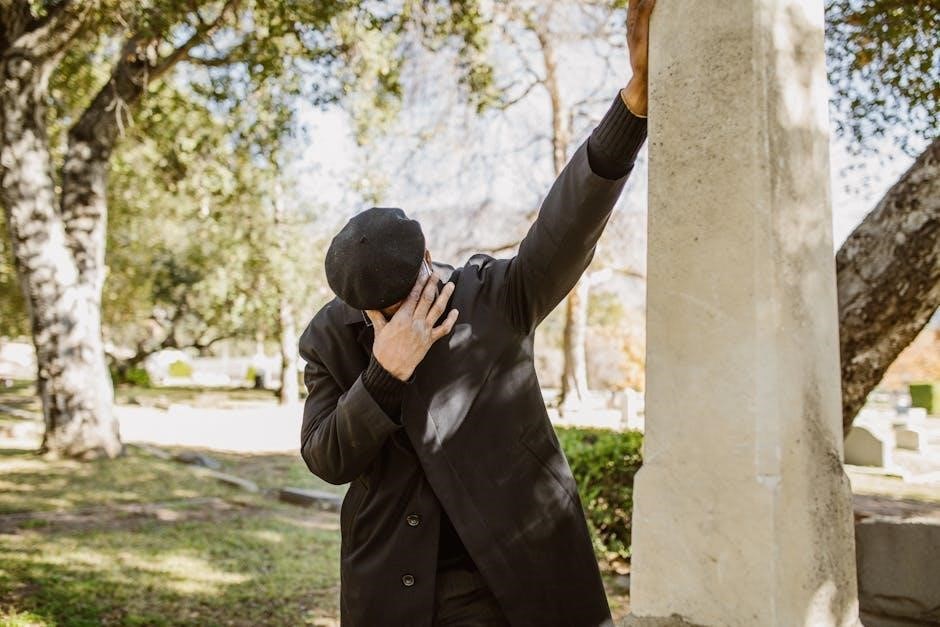Mourner’s Kaddish: A Comprehensive Overview
The Mourner’s Kaddish, Yitgadal veyitkadash shmei raba, is a Jewish prayer recited in memory of the dead. This sacred text praises God and expresses a wish for peace. Traditionally, it is said in Aramaic, requiring a minyan (quorum of ten Jews) for recitation.
What is the Mourner’s Kaddish?
The Mourner’s Kaddish, a central prayer in Jewish tradition, isn’t explicitly about mourning. Instead, it serves as a public affirmation of faith and a sanctification of God’s name, even in times of grief. Recited in Aramaic, the Kaddish emphasizes the greatness and holiness of God, expressing a wish for His kingdom to be established on Earth. It is a communal prayer, traditionally requiring a minyan (a quorum of ten Jewish adults) for its recitation.
This prayer is a vital part of the mourning process, offering solace and a sense of connection to both the community and Jewish tradition. While often associated with death, the Kaddish doesn’t directly mention it. Saying Kaddish helps mourners remain part of the community during bereavement.
Significance and Purpose of Reciting Kaddish
Reciting the Mourner’s Kaddish holds profound significance within Judaism, serving multiple purposes for both the individual mourner and the community. Primarily, it acts as a public declaration of faith in God’s greatness during a time of personal loss. By sanctifying God’s name, the mourner affirms their belief in divine justice and the ultimate goodness of creation, even amidst sorrow.
The Kaddish also provides a structured framework for grief, offering a ritualized way to express mourning and connect with Jewish tradition. The communal aspect of reciting the Kaddish, requiring a minyan, reinforces the importance of community support during bereavement. It ensures that the mourner remains integrated within the community, preventing isolation during a difficult period. Furthermore, reciting Kaddish is seen as a merit for the deceased soul.

The Text of the Mourner’s Kaddish
The Mourner’s Kaddish is primarily recited in Aramaic. The text includes praises to God and expresses hope for the establishment of God’s kingdom. Translations and transliterations are often used for understanding and pronunciation.
Aramaic Text and Transliteration
The core of the Mourner’s Kaddish lies in its ancient Aramaic text. Reciting it in its original language connects mourners to centuries of Jewish tradition. While many understand the importance of the prayer, grasping the nuances of Aramaic can be challenging for some.
To bridge this gap, transliterations are often provided. A transliteration uses the English alphabet to represent the sounds of the Aramaic words, making it easier for individuals to pronounce the prayer correctly, even without formal knowledge of the Aramaic language.
The transliterated text serves as a phonetic guide, ensuring that the essence and rhythm of the Kaddish are preserved. This method allows mourners to participate fully in the communal recitation, fostering a sense of unity and shared remembrance during a difficult time. It enables engagement even without linguistic expertise.
English Translation and Interpretation
While the Aramaic text holds deep historical and spiritual significance, understanding the English translation of the Mourner’s Kaddish is crucial for grasping its meaning. The translation reveals that the Kaddish is not primarily a prayer for the deceased, but rather a glorification of God’s name. It speaks of God’s greatness and the hope for the establishment of God’s kingdom on Earth.
Interpretations of the Kaddish often highlight its focus on life and the future. By affirming God’s sovereignty, even in the face of loss, mourners express faith and resilience. The prayer serves as a reminder that even in times of grief, there is still reason to praise and find meaning.
Various translations and interpretations exist, each offering a unique perspective on the prayer’s message. Some emphasize the themes of hope and redemption, while others focus on the acceptance of God’s will. Exploring these different interpretations can provide deeper insights into the Kaddish.

When and Where to Recite the Mourner’s Kaddish
The Mourner’s Kaddish is traditionally recited during synagogue services. It is said at specific points during the service. Reciting it at home isn’t typical. A minyan, a quorum of ten adults, is generally required.
Specific Times for Recitation
The Mourner’s Kaddish is traditionally recited at specific times during Jewish prayer services; These include the conclusion of the Amidah (the standing prayer), after certain scriptural readings, and at the end of a study session. The Kaddish serves as a division between different sections of the service, marking transitions and signaling the conclusion of particular segments. It is commonly recited during the Shacharit (morning), Mincha (afternoon), and Maariv (evening) services, providing mourners with multiple opportunities to participate in its recitation throughout the day.
The recitation schedule ensures that mourners have consistent opportunities to honor their loved ones. It also allows them to connect with the community in a structured and meaningful way. The Kaddish offers solace and support during the mourning period. Adherence to the prescribed times reinforces the communal aspect of grief and remembrance within Jewish tradition. These specific times are deeply rooted in Jewish customs.
The Importance of a Minyan
The Mourner’s Kaddish holds significant importance when recited in the presence of a minyan, a quorum of ten Jewish adults. This requirement underscores the communal aspect of mourning and remembrance within Jewish tradition. Reciting Kaddish with a minyan emphasizes that grief is not experienced in isolation but is shared and supported by the community. The presence of a minyan transforms the recitation into a public act of solidarity, providing comfort and strength to the mourner.
The minyan serves as a tangible representation of the community’s support, reminding the mourner that they are not alone in their sorrow. The collective recitation amplifies the prayer’s impact, creating a powerful and uplifting experience. The Kaddish recited with a minyan becomes a shared expression of faith and resilience, strengthening the bonds within the community and honoring the memory of the deceased. This communal aspect offers solace during a difficult time.

The Mourner’s Kaddish: Personal Meaning and Modern Interpretations
The Mourner’s Kaddish, beyond its traditional structure, holds deep personal meaning. Modern interpretations explore its relevance to individual experiences of grief and remembrance, adapting its message for contemporary understanding and practice within various Jewish movements.
Individual Reflections on Saying Kaddish
Reciting the Mourner’s Kaddish is a deeply personal journey, unique to each individual navigating grief. For some, it is a way to maintain a connection with the deceased, ensuring their memory remains a vibrant part of their lives. The act of saying Kaddish can offer solace, providing a structured framework for expressing sorrow and finding moments of peace amidst the pain;
Many find comfort in the communal aspect of reciting Kaddish, feeling supported by the minyan and connected to a larger tradition. The prayer’s focus on praising God, rather than directly mourning the dead, can shift the perspective towards gratitude and affirmation of life. Some see Kaddish as a way to honor their loved one’s legacy by publicly affirming their faith and values.
For others, saying Kaddish can be a challenging experience, particularly if they struggle with aspects of traditional Jewish belief. However, even those with doubts may find meaning in the act of remembrance and the opportunity to connect with their community. The consistent recitation provides a daily ritual that marks the passage of time and allows for gradual healing.
Reform and Reconstructionist Perspectives
The Reform and Reconstructionist movements offer evolving perspectives on the Mourner’s Kaddish, reflecting their commitment to both tradition and contemporary values. These movements often emphasize the personal meaning and emotional impact of the prayer, rather than strict adherence to traditional interpretations. They may encourage individuals to adapt the Kaddish to better reflect their own beliefs and experiences.
In some Reform congregations, the requirement of a minyan for reciting Kaddish may be relaxed, allowing individuals to say the prayer even when a quorum is not present. This reflects a greater emphasis on individual spiritual needs and a desire to make the Kaddish accessible to all mourners. English translations and interpretations are frequently used alongside or in place of the traditional Aramaic text, ensuring that the prayer is understandable and meaningful to contemporary worshippers.

Reconstructionist Judaism, with its focus on evolving religious practices, may encourage creative adaptations of the Kaddish. This could involve incorporating personal reflections, poems, or other readings into the service. The goal is to create a more inclusive and meaningful experience for mourners, allowing them to express their grief in a way that resonates with their individual beliefs and values.
